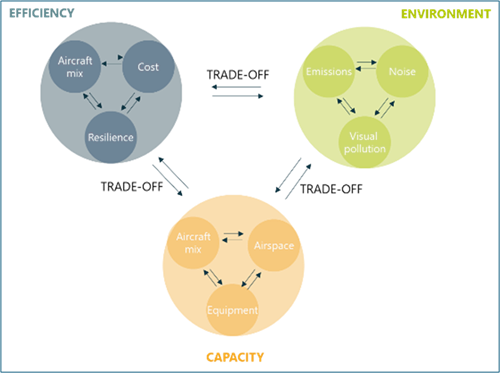The Department for Transport and the Civil Aviation Authority (CAA) are jointly leading a programme to modernise UK airspace. This includes structural redesign, enhancing the functionality of operational systems and leveraging new technology to better integrate and manage all forms of air traffic. A key component is PBN, a system enabling precise flight paths that can help reduce carbon emissions and fuel costs while improving operational accuracy.
A quick explainer
As a concept, PBN is nothing new. It has helped increase enroute capacity and contributed to emissions reduction. It also provides an effective way for aerodromes to implement instrument approach and departure procedures without needing to rely on physical infrastructure. However, it increases reliance on satellite navigation (GNSS), which is increasingly subject to jamming and other attacks.
From a deployment perspective, the difficulty in minimising local impacts can be exacerbated by the technical requirements and limitations on PBN when used in congested airspace, with multiple interdependent SIDs and STARs and needing to accommodate a mix of conventional procedures for non-equipped aircraft. Route design might be the easiest part when you consider the complex Air Traffic Control procedures and the lengthy regulatory approvals needed.
The trade-offs

Achieving the potential benefits of PBN requires balancing several factors which have a direct impact on the operation. It will not always be possible to balance all the competing requirements, and selecting the priorities may need to consider more than just local impacts. The figure above illustrates this dependency. As the PBN impact moves further away from the airport into the wider TMA and connections to the enroute phase, the complexity of balancing the different options becomes even greater. For example, as part of work to modernise the airspace in Amsterdam Schiphol’s Terminal Manoeuvring Area (TMA), Egis tested 156 individual scenarios across six key measures for two different time horizons. This involved 588 runs through fast-time simulation software to identify efficiency and capacity impacts and 96 runs through noise modelling software to evaluate the environmental impacts of the various measures.
1. Environment
PBN has a role to play by providing stabilised flight profiles and supporting continuous climb and descent operations. Given the precise nature of the track that is to be flown, this means that modern flight management systems can optimise the trajectory. FASI proposals to move stacks higher would support this but could lead to longer PBN routes, decreasing ATC flexibility and potentially impacting capacity.
On departure, the most efficient operation is for the initial climb to be done as quickly as possible (reduced CO2 and minimised fuel burn), which requires more thrust and generates more noise closer to the airport. It’s not just about emissions. Even though modern aircraft are quieter, seeing a stream of planes can still lead to complaints about visual pollution, especially when they overfly an area of outstanding natural beauty.
Nevertheless, airports must work within the constraints of their specific location, such as proximity to urban areas, terrain, and existing infrastructure. This means that these environmental pressures might not be manageable within the PBN design limitations, or they might need to be adjusted due to coordination requirements with nearby airports.
2. Efficiency
A well-designed PBN network ensures efficient aircraft flow. However, maintaining capacity might require more airspace or be limited by the need for compatibility with conventional navigation infrastructure. Minimising the amount of vectoring and enabling continuous climb/descent operations delivers environmental efficiency but potentially at the cost of a reduction in capacity. For example, using only speed control (not vectors) and allowing the aircraft to manage its descent will require STARs to have enough track miles to maintain separation. Retaining level segments and vectoring may increase capacity but will reduce the efficiency, increase the fuel burn and increase the overall costs of the operation.
Recent increases in GNSS jamming and spoofing have highlighted a need for PBN to be designed with backup infrastructure (e.g. DME/DME). This is a problem that is gaining global attention. From an airport’s perspective, this might seem far removed from the local issue, but it can directly impact airline operations. If GNSS is lost because of spoofing, it may not be possible to switch back to PBN for the remainder of the flight (aircraft system dependent), and reversion to vectoring or conventional procedures will have direct impacts on capacity and the environment.
While retaining suitable infrastructure to support such contingencies might be possible for some airports, for other smaller airports, the business case might preclude such investment. Disruption across the network might be a consequence of this trade-off.
3. Capacity
Air travel is recovering quickly to pre-COVID levels. PBN can be an enabler to capacity – given the right volumes of airspace, such as with ‘point merge’. As highlighted by the environmental trade-offs, allowing aircraft to fly their optimal routes means that each needs to be able to calculate its own descent/climb profile. We know from our support to Gatwick trials that PBN technology offers advantages through highly precise lateral track-keeping and maintaining aircraft within an optimal altitude range during descent. However, there is additional complexity in managing arrivals noise, where aircraft type and configuration, descent management, meteorological conditions and terrain absorption all play a part. For example, overly steep descent approaches can also result in higher noise levels due to changes in aircraft configuration, such as increased use of flaps, slats, or speed brakes.
The challenges ahead
While PBN is pivotal to the UK's Airspace Modernisation Strategy, its implementation involves navigating complex trade-offs. Recent live trials and simulation studies have provided critical insights, increasing the industry’s understanding of this essential building block in airspace modernisation. Any change to the PBN environment requires an analysis of the trade-offs, flight trials, consultation and engagement with all stakeholders to address concerns, explain the complexities and achieve consensus. These can be time-consuming and contentious, making the use of fast time simulations that consider airspace constraints and fleet mix a valuable tool for down-selection and balancing requirements.
----------
Note: this article was originally published in the Airports UK 'The Airport Operator' magazine, issue Spring 2025.

